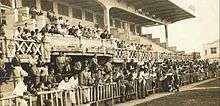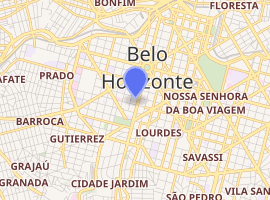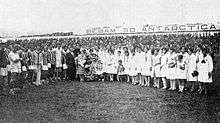Estádio Presidente Antônio Carlos
The Estádio Presidente Antônio Carlos, commonly known as Estádio de Lourdes and colloquially as Estadinho da Colina ("Hill's Small Stadium") was a stadium located in Belo Horizonte, Brazil, owned by Atlético Mineiro. The ground, opened in the Lourdes neighborhood on 30 May 1929, had an estimated capacity of 5,000 and was Atlético's home until 1950. It remained largely unused by the first squad until its demolition in 1994, when a shopping mall was built on the site.
Estádio de Lourdes, Estadinho da Colina | |
 | |

| |
| Location | Belo Horizonte, Brazil |
|---|---|
| Coordinates | 19°55′41″S 43°56′50″W |
| Owner | Atlético Mineiro |
| Capacity | c. 5,000 |
| Surface | Grass |
| Construction | |
| Broke ground | 1928 |
| Opened | 1929 |
| Closed | 1969 |
| Demolished | 1994 |
| Tenants | |
| Atlético Mineiro (1929–1950) | |
History
In its early days, Atlético Mineiro first played its matches at the Municipal Park of Belo Horizonte, before moving in 1909 to a ground at Guajajaras Street, in downtown Belo Horizonte. Atlético eventually received from the Belo Horizonte municipal government a property at Paraopeba Avenue (later Augusto de Lima Avenue), in which it built its first official home ground. Rival club América had its first stadium across the street.[1]

In 1925 Atlético Mineiro reached an agreement with the municipality of Belo Horizonte to exchange the ground where its former stadium was located, at Paraopeba Avenue, to a new land in the Lourdes bairro. Three years later construction began, helped by state governor Antônio Carlos Ribeiro de Andrada, and the stadium opened on 30 May 30, 1929, in a friendly against Corinthians won by Atlético 4–2.[2] The following year, the stadium was visited by then FIFA president Jules Rimet, who for the first time watched a night game, a 10–2 victory by Atlético over Sport which marked the inauguration of the ground's floodlights.[3] The stadium was responsible for a rise in the population and people circulation of the neighborhood.[4]
In the Antônio Carlos, Atlético Mineiro won its first competition at national level, the 1937 Copa dos Campeões Estaduais, after defeating Espírito Santo's Rio Branco 5–1.[5] The stadium was Atlético's home from 1929 to 1950, when the larger Independência was built in Belo Horizonte to host matches of the 1950 FIFA World Cup, and the older and smaller stadium fell out of favor, the stands being used as youth academies sleeping quarters.[6] The ground was sold to the Belo Horizonte municipality by the club in the 1960s to placate a financial crisis, and closed in 1969. After decades of legal disputes, property of the estate eventually returned to Atlético Mineiro in 1991, which then leased it to a shopping mall, built on the site where the stadium once was and inaugurated in 1996.[7]
References
- Couto, Euclides (2007). "Conflito e integração social: paradoxos do futebol em Belo Horizonte (1908-1927)" [Conflict and social integration: paradoxes of football in Belo Horizonte (1908-1927)] (pdf). Anais do XXIV Simpósio Nacional de História (in Portuguese). Retrieved 22 July 2016.
- Sá, Ludymilla (23 June 2012). "Nossa história: tempos de glórias do futebol mineiro onde hoje está o Diamond Mall" [Our history: glory days of Minas Gerais football where today is Diamond Mall]. Estado de Minas (in Portuguese). Retrieved 20 August 2015.
- "História do Atlético: principais fatos e conquistas" (in Portuguese). Clube Atlético Mineiro official website. Retrieved 20 August 2015.
- "Deliberação nº 105/2009". Prefeitura de Belo Horizonte (in Portuguese). 16 December 2009. Retrieved 10 September 2015.
- "O Athletico Campeão dos Campeões" [Athletico Champion of Champions]. Jornal dos Sports (in Portuguese). 4 February 1937. Retrieved 25 August 2015 – via Biblioteca Nacional Digital.
- "Conheça a história do Estádio Presidente Antônio Carlos, casa do Atlético no início do século XX" [Meet the history of Presidente Antônio Carlos Stadium, Atlético's home in the start of the 20th century]. Veja BH (in Portuguese). 28 March 2014. Archived from the original on 5 October 2015. Retrieved 10 September 2015.
- Muniz, Livia (27 February 2015). "Uma viagem aos antigos estádios de América-MG, Atlético-MG e Cruzeiro em BH" [A trip to the old stadiums of América (MG), Atlético Mineiro and Cruzeiro in BH]. Goal.com (in Portuguese). Retrieved 26 August 2015.